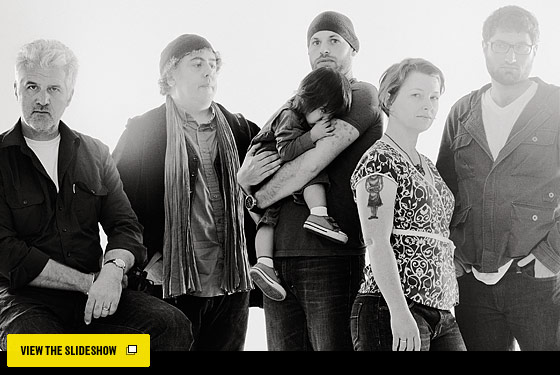
Photograph by Christopher Anderson/Magnum Photos
That Tim Hetherington and Chris Hondros were working side by side when they were killed three weeks ago in the besieged Libyan city of Misurata was no surprise to their friends and fellow photographers, many of whom split their time between the most dangerous parts of the world and living, or crashing on couches, in a Williamsburg apartment building they call “the Kibbutz.” In an age of hypercompetitive journalism, the small number of photographers who travel from front line to front line, following death, poverty, and the atrocities of war, are chummy, even tribal. And with good reason.If you’re going to jump into battle armed only with a camera, the smartest thing you can do is go in there with someone who can help you get out alive.
Danger has always shadowed the job, but since journalists themselves became targets in the wars after 9/11, the stakes have been higher than ever. And for photographers, there is the added risk of being closest to the action. “In a conflict, you will always see video guys and writers kind of at one stage, and the still photographers much further up,” says Benjamin Lowy, who traveled with Hetherington in Libya and was supposed to be with him on the trip where he was killed. That practice has something to do with the demands of the camera lens, he says, and the need to be in people’s faces to capture true emotion at the snap of a shutter. But, Lowy adds, “I also just think it’s in our blood.”
To survive, “you stick with colleagues you trust,” says Yuri Kozyrev, who was with New York Times photographers (and high-school friends) Tyler Hicks and Lynsey Addario in Libya just before they were taken captive in March and who had planned to be on the trip with Hetherington and Hondros, too. “If you are by yourself,” says Kozyrev, “you can just disappear.” Gary Knight, a founding member of the agency VII, puts it more bluntly: “I go in with other people because I don’t want to die alone.”
Being among other conflict photographers also means never having to explain why one does what one does. “You never forget that first taste of war,” says Hicks, who in 1998 financed his own way to Kosovo, where Hondros joined him. “We don’t have a lot of money,” explains Knight. “We don’t have a lot of resources. I wouldn’t say there’s a type, but we’re all pretty similar characters. And we’re out there. We’re at the far end. It’s an old cliché, but you can’t photograph from a hotel room.” As Samantha Appleton puts it, “Once you’ve trusted your life in a car with someone while there’s shelling around you, you’re bonded in a way that’s straight to the bone.”
Hetherington and Hondros had each been through plenty of dangerous conflicts, and both knew their way around a war zone. “When I found out Tim was going with Chris, I felt much better,” says Michael Kamber, one of Hetherington’s closest friends. But as often happens, Knight explains, “everything seems fine until it’s not. Tim and Chris had all the experience in the world, and shit happens. You can’t control the environment you’re in.” To make matters more excruciating for their friends, Hetherington bled to death after being struck by shrapnel. Had he been with one of them, and had they been unharmed and able to fashion a camera-strap tourniquet, could this all have turned out differently?
Recently, Hondros and Hetherington’s fellow photojournalists have again been finding comfort in numbers. As they heard, Tim’s friends automatically headed to the Kibbutz, and then everybody met at the Half King bar for a spontaneous wake. For Hondros’s memorial on April 27 (Hetherington’s are planned for May 13 in London and May 24 in New York), photojournalists flew in from Italy, France, Moscow. Some knew Hondros better, some were closer to Hetherington, but everybody knew somebody.
“Chris’s funeral was the place where for the first time I saw everyone together, all at one time, all in the United States. I’d never seen that before,” says Hicks. “I remember thinking as I was looking around at everyone just how special of a group that we have,” says Mario Tama, one of Getty’s New York staff photographers. “No one wanted to leave; no one wanted it to end. And once we cried on the shoulder of the person next to us, there were 100 or 200 other people in concentric circles all around us, and we could hug each one of them with the same depth of meaning and feeling.”
The week after the deaths, twenty friends agreed to be photographed for the spread that appears in the preceding pages. “This community is like a family,” says Christopher Anderson, who shot the photographs and appears in one of them. “There is a brotherhood-slash-sisterhood, and to me, I wanted to create a family album to pay tribute to our two missing friends by kind of recognizing their absence within these pictures.”
See Also
Shooters: The City’s War Photographers Mourn Two of Their Own
The Chris Hondros Fund will encourage and assist aspiring photojournalists, aid photojournalists and other journalists in conflict zones and raise awareness of issues surrounding their work. Contributions could be made by check to The Chris Hondros Fund, c/o Getty Images, 75 Varick St., 5th Floor, New York, NY 10013.
The João Silva Fund will assist Silva (Slides 6, 7, and 28), who lost both his legs in Afghanistan in October 2010, and his family as he goes through rehabilitation, adjusts to a new life without legs, and starts a new career line. He will likely not be back to work for two years, and will likely never be able to work in conflict zones again. You can donate here: joaosilva.photoshelter.com.




























